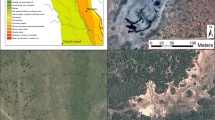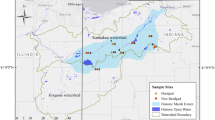Abstract
The use of dredge material is a well-known technique for creating or restoring salt marshes that is expected to become more common along the Gulf of Mexico coast in the future. However, the effectiveness of this restoration method is still questioned. Wetland structural characteristics were compared between four created and three natural salt marshes in southwest Louisiana, USA. The created marshes, formed by the pumping of dredge material into formerly open water areas, represent a chronosequence, ranging in age from 3 to 19 years. Vegetation and soil structural factors were compared to determine whether the created marshes become more similar over time to the natural salt marshes. Vegetation surveys were conducted in 1997, 2000, and 2002 using the line-intercept technique. Site elevations were measured in 2000. Organic matter (OM) was measured in 1996 and 2002, while bulk density and soil particle-size distribution were determined in 2002 only. The natural marshes were dominated by Spartina alterniflora, as were the oldest created marshes; these marshes had the lowest mean site elevations (<30 cm NGVD). The six-year-old created marsh (formed in 1996) was higher in elevation (> 35 cm NGVD) and became dominated by high marsh (S. patens, Distichlis spicata) and shrub (Baccharis halimifolia, Iva frutescens) species. The higher elevation marsh seems to be following a different plant successional trajectory than the other marshes, indicating a relationship between marsh elevation and species composition. The soils in both the created and natural marshes contain high levels of clays (30–65 %), with sand comprising < 1 % of the soil distribution. OM was significantly greater and bulk density significantly lower in two of the natural marshes when compared to the created marshes. The oldest created marsh had significantly greater OM than the younger created marshes, but it may still take several decades before equivalency is reached with the natural marshes. Vegetation structural characteristics in the created marshes take only a few years to become similar to those in the natural marshes, just so long as the marshes are formed at a proper elevation. This agrees with other studies from North Carolina and Texas. However, it will take several decades for the soil characteristics to reach equivalency with the natural marshes, if they ever will.
Similar content being viewed by others
Literature cited
Allen, T. F. H. and T. W. Hoekstra. 1992. Toward a Unified Ecology. Columbia University Press, New York, NY, USA.
Beals, E. W. 1984. Bray-Curtis ordination: an effective strategy for analysis of multivariate ecological data. Advances in Ecological Research 14:1–55.
Boesch, D. F., M. N. Josselyn, A. J. Mehta, J. T. Morris, W. K. Nuttle, C. A. Simenstad, and D. J. P. Swift. 1994. Scientific assessment of coastal wetland loss, restoration and management in Louisiana. Journal of Coastal Research 20:1–103.
Bourne, J. 2000. Louisiana’s vanishing wetlands: Going, going…. Science 289:1860–1863.
Chabreck, R. H. 1989. Creation, restoration, and enhancement of marshes of the northcentral Gulf coast. p. 127–144. In J. A. Kusler and M. E. Kentula (eds.) Wetland Creation and Restoration: The Status of the Science. U.S. Environmental Protection Agency, Environmental Research Laboratory, Corvallis, OR, USA. EPA 600/3-89/038a.
Chabreck, R. H. 1994. Marsh management in Louisiana for production of emergent and aquatic plants. Report prepared for the Louisiana Landowners Association, Inc., Baton Rouge, LA, USA.
Coleman, D. C. and D. A. Crossley. 1996. Fundamentals of Soil Ecology. Academic Press, San Diego, CA, USA.
Craft, C. B., S. W. Broome, and E. D. Seneca. 1988. Nitrogen, phosphorus and organic carbon pools in natural and transplanted marsh soils. Estuaries 11:272–280.
Craft, C. B., J. M. Reader, J. N. Sacco, and S. W. Broome. 1999. Twenty-five years of ecosystem development of constructed Spartina alterniflora (Loisel) marshes. Ecological Applications 9:1405–1409.
Dawe, N. K., G. E. Bradfield, W. S. Boyd, D. E. C. Trethewey, and A. N. Zolbrod. 2000. Marsh creation in a northern Pacific estuary: Is thirteen years of monitoring vegetation dynamics enough? Conservation Ecology 4:12. [online] URL: http://www.consecol.org/vol4/iss2/art12.
Day, J. W., G. P. Shaffer, D. J. Reed, D. R. Cahoon, L. D. Britsch, and S. R. Hawes. 2001. Patterns and processes of wetland loss in coastal Louisiana are complex: a reply to Turner 2001. Estimating the indirect effects of hydrologic change on wetland loss: If the Earth is curved, then how would we know it? Estuaries 24:647–651.
Edwards, K. R., C. E. Proffitt, and S. E. Travis. 2001. Dieback in Spartina alterniflora marshes along the southwest Louisiana coast. p. 17. In R. E. Stewart, Jr., C. E. Proffitt, and T. M. Charron (eds.) Abstracts from “Coastal Marsh Dieback in the Northern Gulf of Mexico: Extent, Causes, Consequences, and Remedies”. U.S. Geological Survey, Biological Resources Division, Information and Technology Report, Washington, DC, USA. USGS/BRD/ITR — 2001-0003.
Gauch, H. G. 1982. Multivariate Analysis in Community Ecology. Cambridge University Press, New York, NY, USA.
Gosselink, J. G. 1984. The ecology of delta marshes of coastal Louisiana: A community profile. U.S. Fish and Wildlife Service, Office of Biological Services, Washington, DC, USA. FWS/OBS-84/09.
Gosselink, J. G. 2001. Comments on “Wetland loss in the northern Gulf of Mexico: Multiple working hypotheses” (R. E. Turner. 1997. Estuaries 20: 1–13). Estuaries 24:636–639.
Gosselink, J. G., C. L. Cordes, and J. W. Parsons. 1979. An ecological study of the Chenier Plain ecosystem of Louisiana and Texas. U.S. Fish and Wildlife Service, Office of Biological Services, Washington, DC, USA. FWS/OBS-78-9.
Grieg-Smith, P. 1964. Quantitative Plant Ecology. Butterworth, London, U.K.
Kentula, M. E., R. P. Brooks, S. E. Gwin, C. C. Holland, A. D. Sherman, and J. C. Sifneos. 1992. Wetlands: An Approach to Improving Decision Making in Wetland Restoration and Creation. Island Press, Washington, DC, USA.
Kusler, J. A. and M. E. Kentula (eds.) 1989. Wetland Creation and Restoration: The Status of the Science. U.S. Environmental Protection Agency, Environmental Research Laboratory, Corvallis, OR, USA. EPA 600/3-89/038a.
Landin, M. C., J. W. Webb, and P. L. Knudson. 1989. Long-term monitoring of eleven Corps of Engineers habitat development field sites built of dredged material, 1974–1987. Waterways Experimental Station, Vicksburg, MS, USA. Waterways Experimental Station Technical Report D-89-1.
Lindau, C. W. and L. R. Hossner. 1981. Substrate characterization of an experimental marsh and three natural marshes. Soil Science Society of America Journal 45:1171–1176.
Ludwig, J. A. and J. F. Reynolds. 1988. Statistical Ecology. John Wiley and Sons, New York, NY, USA.
McCune, B. and M. J. Mefford. 1999. PC-ORD. Multivariate Analysis of Ecological Data, Version 4. MjM Software Design, Gleneden Beach, OR, USA.
Minchin, P. R. 1987. An evaluation of the relative robustness of techniques for ecological ordination. Vegetatio 69:89–107.
Mitsch, W. J. and J. G. Gosselink. 2000. Wetlands, third edition. Van Nostrand Reinhold Company, New York, NY, USA.
Moy, L. D. and L. A. Levin. 1991. Are Spartina marshes a replaceable resource? A functional approach to evaluation of marsh creation efforts. Estuaries 14:1–16.
Penland, S. 2001. Beneficial use of dredged material disposal history: Calcasieu River and pass, LA. U.S. Army Corps of Engineers, New Orleans, LA, USA.
Proffitt, C. E. and J. Young. 1999. Salt marsh plant colonization, growth and dominance on large mudflats created using dredged sediments. p. 218–228. In L. P. Rozas, J. A. Nyman, C. E. Proffitt, N. N. Rabalais, D. J. Reed, and R. E. Turner (eds.) Recent Research in Coastal Louisiana: Natural System Function and Response to Human Influence. Louisiana Sea Grant College Program, Baton Rouge, LA, USA.
Sanzone, S. and A. McElroy (eds.). 1998. Ecological impacts and evaluation criteria for the use of structures in marsh management. U.S. Environmental Protection Agency, Washington, DC, USA. EPA-SAB-EPEC-98-003.
Schumacher, B. A. and C. J. Palmer. 1995. Laboratory methods for soil and foliar analysis in long-term environmental monitoring programs. U.S. Environmental Protection Agency, Washington, DC, USA. EPA/600/R-95/077.
Shafer, D. J. and W. J. Streever. 2000. A comparison of 28 natural and dredged material salt marshes in Texas with an emphasis on geomorphological variables. Wetlands Ecology and Management 8:353–366.
Simenstad, C. A. and R. M. Thom. 1996. Functinal equivalency trajectories of the restored Gog-Le-Hi-Te estuarine wetland. Ecological Applications 6:38–56.
Streever, W. J. 2000. Spartina alterniflora marshes on dredged material: A critical review of the ongoing debate over success. Wetlands Ecology and Management 8:295–316.
SYSTAT. 2002. SYSTAT for Windows, version 10.2. SYSTAT Software, Inc., Richmond, CA, USA.
Thom, R. M. 2000. Adaptive management of coastal ecosystem restoration projects. Ecological Engineering 15:365–372.
Tiner, R. W. 1987. A Field Guide to Coastal Wetland Plants of the Northeastern United States. University of Massachusetts Press, Amherst, MA, USA.
Turner, R. E. 1997. Wetland loss in the northern Gulf of Mexico: Multiple working hypotheses. Estuaries 20:1–13.
Urban, D. L. 1994. Landscape ecology and ecosystem management. p. 127–136. In W. W. Covington and L. F. DeBano (eds.) Sustainable Ecological Systems: Implementing an Ecological Approach to Land Management. U.S. Department of Agriculture, Forest Service, Rocky Mountain Forest and Range Experiment Station, Fort Collins, CO, USA. GTR-RM-247.
Webb, J. W. and C. J. Newling. 1985. Comparison of natural and man-made salt marshes in Galveston Bay complex, Texas. Wetlands 4:75–86.
Zedler, J. B. 1996. Ecological issues in wetland mitigation: an introduction to the forum. Ecological Applications 6:33–37.
Zedler, J. B. 1999. The ecological restoration spectrum. p. 301–318. In W. R. Streever (ed.) An International Perspective on Wetland Rehabilitation. Kluwer Academic Publishers, Dordrecht, The Netherlands.
Zedler, J. B. 2000. Progress in wetland restoration ecology. TREE 15:402–407.
Zedler, J. B. and J. C. Callaway. 1999. Tracking wetland restoration: Do mitigation sites follow desired trajectories? Restoration Ecology 7:69–73.
Zedler, J. B. and J. C. Callaway. 2000. Evaluating the progress of engineered tidal wetlands. Ecological Engineering 15:211–225.
Zedler, J. B. and M. W. Weller. 1989. Overview and future directions. p. 465–473. In J. A. Kusler and M. E. Kentula (eds.) Wetland Creation and Restoration: The Status of the Science. U.S. Environmental Protection Agency, Environmental Research Laboratory, Corvallis, OR, USA. EPA 600/3-89/038a.
Author information
Authors and Affiliations
Corresponding author
Rights and permissions
About this article
Cite this article
Edwards, K.R., Proffitt, C.E. Comparison of wetland structural characteristics between created and natural salt marshes in southwest Louisiana, USA. Wetlands 23, 344–356 (2003). https://doi.org/10.1672/10-20
Received:
Revised:
Accepted:
Issue Date:
DOI: https://doi.org/10.1672/10-20




